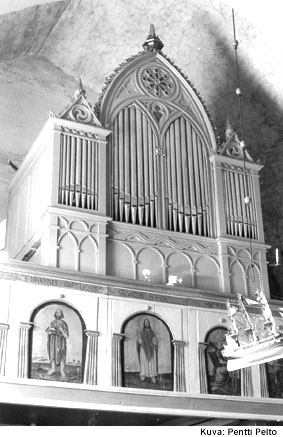
|
HISTORICAL ORGANS IN FINLAND 
Sund Church- Thulé, Anders 1860
- 9 stops, 1 manual and pull-down pedal
- mechanical action and mechanical stop action
The municipality of Sund in the Åland Islands was one of the theatres of the Crimean War: the English fleet attacked the fortress of Bomarsund in 1856. Having blown up the fortress, the fleet continued northwards. The Parish of Sund, confident in a better future, commissioned a new organ soon after these dramatic events. Part of the money towards the cost was donated by squire Wikström, tenant of the local Royal manor. The twin-nave Sund Church, built of stone in the 14th century, is consecrated to St John the Baptist.
The single-manual organ built by Anders Thulé was completed in 1860. Jens Alexander Zachariassen expanded the instrument to two manuals in 1915 with such discretion that the old structures were left all but intact. The instrument is unplayable at present, and parts of it have been lost. However, a visual inspection yields an overall impression of its technology, and its sound can be imagined through study of the details.
Appearance
A beautiful water-coloured India ink drawing for the organ project of Vähäkyrö Church, signed by architect Julius Basilier, was discovered in the Vähäkyrö church archives in 1999. There are contemporary entries in the calendars of Anders Thulé regarding negotiations with Vähäkyrö Parish, but evidently this organ project came to nothing. However, the drawing seems to have had a long-standing influence on organ building in Kangasala, since the façades of many organs up to the 1880s, beginning with Sund, follow the outline of Basilier’s drawing.
The Neo-Gothic façade of the Sund organ is over five metres high and divided into three flats. The middle one is shaped like a pointed arch, while the flanking flats are oblong and topped with pediments. The arched flat is sub-divided into two smaller flats, likewise with pointed arches. All flats have symmetrical groups of pipes. The façade decorations are sparse and simple.
Technical features
Typically for the builder, all the façade pipes are dummies; all the speaking pipes are on top of the chest. The metal pipes are tuned with a curious flap formed from the body of the pipe itself. The only other surviving example of this device is in the Kuorevesi organ, which is in storage in a museum in Tampere. The console is on the left wall of the organ, and the pumping pedal is on the opposite wall.
The chest is immediately behind the façade; it is a very solid slider chest with double bars. The stop action is short, since the sliders extend close to the music stand, under which the stop knobs are placed. Under the chest there are two bellows, the lower being the feeder bellows and the upper one the reservoir.
Simplicity and clarity are hallmarks of Anders Thulé’s style, and the Sund organ is a fine case in point.
Zachariassen’s expansion
The Sund organ was rapidly becoming outdated in the early 20th century. The answer was to extend the instrument with a second manual and a Subbass stop, which was considered essential. Zachariassen built the extension using a pneumatic action. He placed the new components on the right side of the organ, almost out of sight.
Disposition
Manual I C-f3 (AT 1860) | Manual II C-f3 (Z 1915) | Pedal C-d1 (Z 1915) |
Borduna 16fot | Liebl.gedackt 8' | Subbass 16' |
Principal 8f | Salicional 8' | |
Dubbelfleut 8f | Aeoline 8' | |
Fugara 8f | | |
Octava 4f | | |
Fleute 4f | | |
Qvinta 3f | | |
Octava 2f | | |
Trompet 8f | | |
| | |
| | |
| | |
| | |
|
|
|
Zachariassen replaced the Trompet with a new Viola di Gamba 8’. | | |
II-I, I-Ped, II-Ped, I 4’. | | |
Fixed couplers piano, forte, fortissimo | | |
| | |
| | |
| | |
| | |
| | |
| | |
| | |
| | |
| | |
| | |
Further information
Pentti Pelto, Kaksi suomalaista urkuperinnettä. Dissertation, Sibelius Academy 1994.
Pentti Pelto, Urut joita ei rakennettu, in Pelto (ed.), Vähänkyrön urkujen kirja. Vähäkyrö 2000.
|